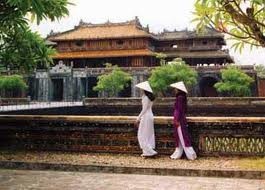(VOVworld)-The city of Hue, the former imperial capital of Vietnam, has a history of more than two thousand years. It is a city steeped in tradition, culture, and art, which is home to two globally recognized cultural heritages: the Hue Imperial City complex and Royal Court Music. VOV reporter Vinh Phong spotlights the city’s efforts to preserve its heritages.

Hue Royal Citadel
|
Through many historical upheavals Hue has managed to preserve a huge collection of artifacts from the ancient Sa Huynh culture dating back more than 2500 years. The city is also home to Champa cultural relics and hundreds of old pagodas typical of Vietnam’s Buddhist architecture. Nguyen Van Cao, President of the Thua Thien Hue provincial People’s Committee, says: “The Hue Relics Preservation Centre is in charge of implementing many programs and projects to preserve and restore cultural heritages nationwide.” This year, the centre is setting up projects to restore the city’s relic sites including the Imperial Palaces system, Cần Chánh and Kiến Trung palaces, Noon Gate, and Thiên Thọ Tomb. The centre is also conducting scientific research on intangible cultural heritages, and improving external and exhibition activities to better promote Hue’s many valuable relics to the world. Director of the Thua Thien-Hue Culture, Sports and Tourism Department Phan Tien Dung: "Preserving cultural heritages is part of our provincial development strategy so we have allocated much of our investment resources to restoring relics and cultural heritages. Once we succeed in this job, we will further develop the Hue Festival. Over the past 10 years, we have moved 15 factories, some of them with more than 2000 workers, out of the Hue Imperial City. This reflects the local authorities’ determination to keep our cultural heritages undamaged. Hue people have also voluntarily moved their houses out of the citadel to protect the city’s relics."
The province is implementing dozens of projects to preserve and develop its special music genre of royal court music. Since the art form was recognized by UNESCO in 2003 as a “Masterpiece of the Oral and Intangible Heritage of Humanity”, the province has collected and restored more than 30 royal court music pieces for ritual ceremonies, 20 royal dances, and 3 ancient classical dramas. Deputy chairman of the Thua Thien Hue provincial People’s Committee Ngo Hoa told VOV: "Since 2003, thanks to Japanese government sponsors mandated by UNESCO in Vietnam, we have organized training classes for royal court music. This project, praised by UNESCO, is the first solid project to help Vietnam’s younger generations develop the country’s intangible heritages. We believe this art form will be further developed and introduced to a wider public both inside and outside the country."
Hue city is gearing up efforts to preserve its tangible and intangible heritages in the hope of securing a permanent place for the former imperial city and its festivals in the hearts of all tourists who come to Hue.
Vinh Phong